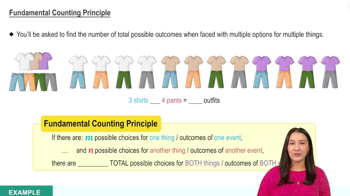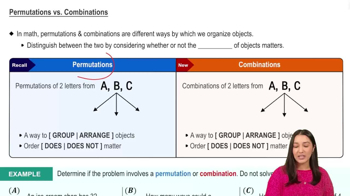Quinela In a horse race, a quinela bet is won if you selected the two horses that finish first and second, and they can be selected in any order. The 144th running of the Kentucky Derby had a field of 20 horses. What is the probability of winning a quinela bet if you randomly select the horses?
Table of contents
- 1. Intro to Stats and Collecting Data1h 14m
- 2. Describing Data with Tables and Graphs1h 55m
- 3. Describing Data Numerically2h 5m
- 4. Probability2h 16m
- 5. Binomial Distribution & Discrete Random Variables3h 6m
- 6. Normal Distribution and Continuous Random Variables2h 11m
- 7. Sampling Distributions & Confidence Intervals: Mean3h 23m
- Sampling Distribution of the Sample Mean and Central Limit Theorem19m
- Distribution of Sample Mean - Excel23m
- Introduction to Confidence Intervals15m
- Confidence Intervals for Population Mean1h 18m
- Determining the Minimum Sample Size Required12m
- Finding Probabilities and T Critical Values - Excel28m
- Confidence Intervals for Population Means - Excel25m
- 8. Sampling Distributions & Confidence Intervals: Proportion1h 12m
- 9. Hypothesis Testing for One Sample3h 29m
- 10. Hypothesis Testing for Two Samples4h 50m
- Two Proportions1h 13m
- Two Proportions Hypothesis Test - Excel28m
- Two Means - Unknown, Unequal Variance1h 3m
- Two Means - Unknown Variances Hypothesis Test - Excel12m
- Two Means - Unknown, Equal Variance15m
- Two Means - Unknown, Equal Variances Hypothesis Test - Excel9m
- Two Means - Known Variance12m
- Two Means - Sigma Known Hypothesis Test - Excel21m
- Two Means - Matched Pairs (Dependent Samples)42m
- Matched Pairs Hypothesis Test - Excel12m
- 11. Correlation1h 6m
- 12. Regression1h 50m
- 13. Chi-Square Tests & Goodness of Fit1h 57m
- 14. ANOVA1h 57m
4. Probability
Counting
Problem 4.4.21
Textbook Question
Phone Numbers Current rules for telephone area codes allow the use of digits 2–9 for the first digit, and 0–9 for the second and third digits, but the last two digits cannot both be 1 (to avoid confusion with area codes such as 911). How many different area codes are possible with these rules? That same rule applies to the exchange numbers, which are the three digits immediately preceding the last four digits of a phone number. Given both of those rules, how many 10-digit phone numbers are possible? Given that these rules apply to the United States and Canada and a few islands, are there enough possible phone numbers? (Assume that the combined population is about 400,000,000.)
 Verified step by step guidance
Verified step by step guidance1
Step 1: Calculate the number of possible area codes. The first digit of the area code can be any digit from 2 to 9, giving 8 choices. The second and third digits can each be any digit from 0 to 9, giving 10 choices each. However, the last two digits cannot both be 1, so we subtract 1 from the total combinations of the second and third digits. The total number of area codes is therefore calculated as: (8 choices for the first digit) × (10 choices for the second digit) × (10 choices for the third digit) - 1 (to exclude the case where the last two digits are both 1).
Step 2: Calculate the number of possible exchange numbers. The same rules apply to the exchange numbers as to the area codes. The first digit can be any digit from 2 to 9 (8 choices), the second and third digits can each be any digit from 0 to 9 (10 choices each), and the last two digits cannot both be 1. The total number of exchange numbers is therefore calculated in the same way as the area codes: (8 choices for the first digit) × (10 choices for the second digit) × (10 choices for the third digit) - 1.
Step 3: Calculate the total number of 10-digit phone numbers. A 10-digit phone number consists of an area code, an exchange number, and four remaining digits. The four remaining digits can each be any digit from 0 to 9, giving 10 choices for each digit. The total number of 10-digit phone numbers is therefore: (number of possible area codes) × (number of possible exchange numbers) × (10 choices for the first remaining digit) × (10 choices for the second remaining digit) × (10 choices for the third remaining digit) × (10 choices for the fourth remaining digit).
Step 4: Compare the total number of possible phone numbers to the population. Given that the combined population of the United States, Canada, and a few islands is approximately 400,000,000, compare the total number of possible phone numbers to this population to determine if there are enough phone numbers available. Specifically, check if the total number of phone numbers exceeds the population.
Step 5: Conclude whether there are enough phone numbers. Based on the comparison in Step 4, determine if the total number of possible phone numbers is sufficient to meet the needs of the population. If the total number of phone numbers is significantly larger than the population, then there are enough phone numbers available.
 Verified video answer for a similar problem:
Verified video answer for a similar problem:This video solution was recommended by our tutors as helpful for the problem above
Video duration:
5mPlay a video:
Was this helpful?
Key Concepts
Here are the essential concepts you must grasp in order to answer the question correctly.
Combinatorial Counting
Combinatorial counting involves determining the number of ways to arrange or select items from a set, often using principles such as the multiplication rule. In this context, it helps calculate the total number of valid area codes and phone numbers by considering the restrictions on digit placement.
Recommended video:

Fundamental Counting Principle
Permutations and Combinations
Permutations and combinations are fundamental concepts in combinatorics that deal with the arrangement and selection of items. For area codes and phone numbers, understanding how to apply these concepts allows for the calculation of different valid combinations of digits while adhering to the specified rules.
Recommended video:

Permutations vs. Combinations
Population vs. Phone Number Capacity
This concept compares the total number of possible phone numbers to the population size to assess if there are enough unique phone numbers for everyone. By calculating the total number of valid 10-digit phone numbers, one can determine if the available combinations exceed the population of 400 million.
Recommended video:
Guided course

Visualizing Qualitative vs. Quantitative Data

 7:11m
7:11mWatch next
Master Introduction to Permutations with a bite sized video explanation from Patrick
Start learningRelated Videos
Related Practice
Textbook Question
